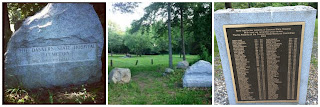Warning:
This post is about a disturbing subject. Upsetting pictures are used as well.
People tend to not believe in
monsters—but unfortunately they do exist.
 |
| Danvers State Hospital |
Danvers State Hospital opened
in 1878. Its first name was the State Lunatic
Hospital.
 |
| Danvers Sunroom |
This hospital’s design was
based upon Dr. Thomas Kirkbride’s concept that if mental patients were provided
with sunlight and fresh air, more would experience recovery.
Early in its history, the hospital did help many patients who then were released.
Danvers’ history is similar
to several other mental hospitals I have written about. It was designed to
house five hundred patients, but by the 1920s the population had grown to well
over one thousand.
This and a lack of funding
resulted in the hospital being extremely short-staffed. Patients were often
left sick and living in filth.
 |
| Cuffs instead of nurses. |
The staff, in efforts to
manage the patients, turned to inhumane practices. “Straitjackets, solitary
confinement, and restraints were used. Patients were also subjected to
hydrotherapy and electroshock treatments.”
But the worst method used was
a new invention pioneered by Danvers’ own Dr. Walter Freeman in 1936. The
‘good’ doctor was a surgeon who would cut into a patients’ brain and sever the
frontal lobes and the thalamus---a lobotomy.
Keep in mind--not all mental
patients were violent, etc. But this surgery tragically was used as a “cure
all.”
 |
| Dr. Feeman performing a lobotomy. Click to enlarge. |
Dr. Freeman decided this
surgery took too long, so he adopted a method used in Italy that eliminated the
need to cut or drill. (Warning this is not for the squeamish).
He instead, would take an
icepick and shove it into the inner corner of a patient’s eye he then would
punch it through their skull to reach the brain.
 |
| Lobotomy tool |
He finally would just
scramble or stir the frontal lobe until it was no longer functional.
He did this without giving
his patients an anesthetic.
 |
| Patient After and Before Lobotomy. |
He became so proficient at
this procedure that he took it ‘on the road.’ He traveled in a vehicle he
called his Lobotmobile and visited
other mental institutions where he would train staffs on how to do this
technique.
At every institution, he
visited he offered to perform lobotomies, for the low price of just $25 a
patient. Many of these patients lost their ability to feed themselves or use
the restroom on their own.
Fifteen percent of these
patients died. Others relapsed so Freeman would then just do the procedure
again.
In 1951, at Iowa’s Cherokee
Mental Hospital, reporters were there to cover this miraculous surgery. Freeman
stopped in the middle of a procedure so he could pose for the cameras. His
icepick slipped—going too deep—which immediately killed the patient.
He never wore gloves or a
mask, his son later in a PBS interview admitted the icepick he initially used
was from their family kitchen.
 |
| Before lobotomies--they are smiling-- and After pictures of victims. |
Freeman performed thirty-five
hundred lobotomies in twenty-three states during this obscene sideshow. Many of
his victims were minors—one being just four-years-old.
The use of lobotomies at
Danvers ended in 1954—because the controversial drug Thorazine a “chemical
lobotomy” was developed.
By 1992, this hospital was
abandoned. For the next ten years, its only residents were the homeless.
With this horrible and sad
history, it is not surprising some believe this site is haunted.
While the old hospital still
stood, many paranormal groups tried to obtain permission to do investigations.
But the state of Massachusetts prohibited this.
In 2005 a developer purchased
the property, and the remaining buildings were demolished. Then several
apartment complexes were built.
But people’s curiosity
remained, is this site haunted?
The state still maintains the
Danvers’ cemetery that remains on the property. Hundreds of small stones with
just “a number” on them mark the location of each patient that went unclaimed
by relatives. At the entrance, a large boulder stands, with the engraving—“The Echoes They Left Behind.”
There has been no indication
this cemetery is haunted. In a recent effort, people worked to “reclaim” these
patient’s names and now a stone stands with this list.
 |
| Danvers Cemetery |
Despite the fact this ghost
would glare at her, Levasseur states she was never afraid. She saw this spirit
several times, and then it never returned.
The source material used
about Dr. Freeman came from Aaron Mahnke’s book, The World of Lore, Dreadful
Places.


No comments:
Post a Comment